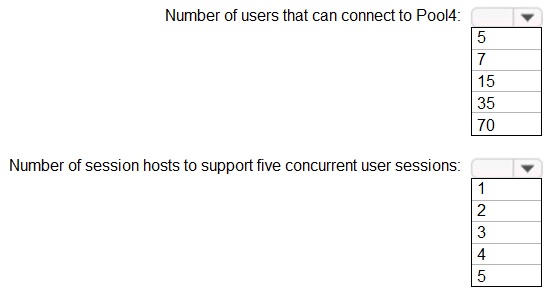Topic 1, Contoso. Ltd
Case study
This is a case study. Case studies are not timed separately. You can use as much
exam time as you would like to complete each case. However, there may be additional
case studies and sections on this exam. You must manage your time to ensure that you
are able to complete all questions included on this exam in the time provided.
To answer the questions included in a case study, you will need to reference information
that is provided in the case study. Case studies might contain exhibits and other resources
that provide more information about the scenario that is described in the case study. Each
question is independent of the other questions in this case study.
At the end of this case study, a review screen will appear. This screen allows you to review
your answers and to make changes before you move to the next section of the exam. After
you begin a new section, you cannot return to this section.
To start the case study
To display the first question in this case study, click the Next button. Use the buttons in the
left pane to explore the content of the case study before you answer the questions. Clicking
these buttons displays information such as business requirements, existing environment,
and problem statements. If the case study has an All Information tab, note that the
information displayed is identical to the information displayed on the subsequent tabs.
When you are ready to answer a question, click the Question button to return to the
question.
Overview
Contoso, Ltd. is a law firm that has a main office in Montreal and branch offices in Paris
and Seattle. The Seattle branch office opened recently.
Contoso has an Azure subscription and uses Microsoft 365.
Existing Infrastructure. Active Directory
The network contains an on-premises Active Directory domain named contoso.com and an
Azure Active Directory (Azure AD) tenant. One of the domain controllers runs as an Azure
virtual machine and connects to a virtual network named VNET1. All internal name
resolution is provided by DNS server that run on the domain controllers.
The on-premises Active Directory domain contains the organizational units (OUs) shown in
the following table.
Which setting should you modify for VNET4 before you can deploy Pool4?
A.
Service endpoints
B.
Address space
C.
DNS servers
D.
Access control (1AM)
E.
Peerings
DNS servers
DNS should be configured to use an Active Directory Domain Controller.
Which three PowerShell modules should you install on Server1 to meet the technical requirements? Each correct answer presents part of the solution.
NOTE: Each correct selection is worth one point.
A.
Pester
B.
RemoteDesktop
C.
ServerManager
D.
ActiveDirectory
E.
Hyper-V
Pester
ActiveDirectory
Hyper-V
Explanation:
Contoso identifies the following technical requirements:
From a server named Server1, convert the user profile disks to the FSLogix profile
containers.
The PowerShell modules for Hyper-V, Active Directory, and Pester are prerequisites to
running the cmdlets to convert user profile disks to FSLogix.
Reference:
https://docs.microsoft.com/en-us/azure/cloud-adoption-framework/migrate/azure-bestpractices/
contoso-migration-rds-to-wvd
Which role should you assign to Operator2 to meet the technical requirements?
A.
Desktop Virtualization Session Host Operator
B.
Desktop Virtualization Host Pool Contributor
C.
Desktop Virtualization User Session Operator
D.
Desktop Virtualization Contributor
Desktop Virtualization Contributor
https://docs.microsoft.com/en-us/azure/virtual-desktop/rba
You need to configure the device redirection settings. The solution must meet the technical requirements. Where should you configure the settings?
A.
Workspace1
B.
MontrealUsers
C.
Group1
D.
Pool1
Pool1
You are planning the deployment of Pool4.
What will be the maximum number of users that can connect to Pool4, and how many
session hosts are needed to support five concurrent user sessions? To answer, select the
appropriate options in the answer area.
NOTE: Each correct selection is worth one point

You need to evaluate the RDS deployment in the Seattle office. The solution must meet the
technical requirements.
Which three actions should you perform in sequence? To answer, move the appropriate
actions from the list of actions to the answer area and arrange them in the correct order.

You need to configure the virtual machines that have the Pool1 prefix. The solution must meet the technical requirements.
What should you use?
A.
a Windows Virtual Desktop automation task
B.
Virtual machine auto-shutdown
C.
Service Health in Azure Monitor
D.
Azure Automation
a Windows Virtual Desktop automation task
https://docs.microsoft.com/en-us/azure/logic-apps/create-automation-tasks-azureresources
You plan to implement the FSLogix profile containers for the Seattle office.
Which storage account should you use?
A.
storage2
B.
storage4
C.
storage3
D.
storage1
storage2
Reference:
https://docs.microsoft.com/en-us/azure/virtual-desktop/store-fslogix-profile
Which users can create Pool4, and which users can join session hosts to the domain? To answer, select the appropriate options in the answer area.
NOTE: Each correct selection is worth one point.

You need to implement network security to meet the security requirements and the
performance requirements.
Which two actions should you perform? Each correct answer presents a complete solution.
NOTE: Each correct selection is worth one point.
A.
Deploy two Azure Firewall instances and Azure Firewall Manager.
B.
Filter traffic by using outbound rules.
C.
Filter traffic by using infrastructure rules.
D.
Filter traffic by using inbound rules.
E.
Deploy a network security group (NSG) and two application security groups.
F.
Deploy an Azure Firewall instance and Azure Firewall Manager.
Deploy two Azure Firewall instances and Azure Firewall Manager.
Filter traffic by using outbound rules.
Reference:
https://docs.microsoft.com/en-us/azure/firewall/protect-windows-virtual-desktop
| Page 1 out of 11 Pages |